This morning I took the train to North-West London on a personal pilgrimage to the Shrine of Our Lady of Willesden. A few weeks ago I received my copy of the new Britain’s holiest places by Nick Mayhew Smith. It’s a wonderful travel guide with personal observations to the places of Christian heritage around Britain. I must confess that I had never heard of Our Lady of Willesden. Reading Mayhew Smith’s one page write-up, I jumped on the train this morning to make pilgrimage.
The Shrine is both oddly English and oddly London. It is in the Parish Church of St Mary Willesden, a rather pretty English parish church surrounded by a verdant graveyard, typical of so many village churches up and down the country. Yet just beyond its stone boundary wall is a busy roundabout with red London double-deckers ferrying passengers to and from Neasden Tube Station.
The church of St Mary dates back to a foundation of King Athelstan, 10th-century King of England and grandson of King Alfred the Great, and was built above the holy well that gives Willesden (well’s ‘down’) its name. The church possesses many hallmarks of its age: an 11th-century oak door, a square stone font of equal age, and the water from the holy well is now piped up into a little fountain in the chancel.
The great treasure of Willesden, however, was its statue of the Blessed Virgin Mary with the Child Jesus, blackened with age — the Black Virgin of Willesden. It was a great mediaeval pilgrimage site, and the statue and well were the source of many a healing miracle. As with so much of our spiritual heritage, the Black Virgin was destroyed during the Reformation, being burned at Chelsea in 1538. Yet devotion could not be so easily destroyed, and, with growing religious tolerance in the 20th century, a new statue was made in 1972 by Catharini Stern. As can be seen from the picture, the statue represents the Christ Child in swaddling clothes with arms outstretched in an ambiguous gesture that is both embrace of the onlooker and foreshadowing of the Cross. A smaller golden statue of the Madonna and Child stands halfway up the chancel. It was introduced in 1902, but is not particularly special, probably being a safe choice between nothing and a full shrine statue.
Unusually, St Josemaría Escrivá, the founder of Opus Dei (and whose feast day was yesterday, 26 June), came to St Mary’s Willesden every time he was in London to pray at the site of the shrine. On the Feast of the Assumption, 15 August 1958, Escrivá held his annual rededication Mass for Opus Dei in this Anglican parish church of Willesden. Because of this, Opus Dei members and many other Catholics make the pilgrimage to Willesden.On a hot day in late June, sitting alone in the cool of this handsome stone building, the holy love of the Mother for her Lord and Saviour was tangibly present, as was the faith of the pilgrims ancient and modern. Willesden is a special place for a pilgrimage, to pray for those who are need, bless one’s self with its holy water and kneel before the Black Virgin and her loving Son.
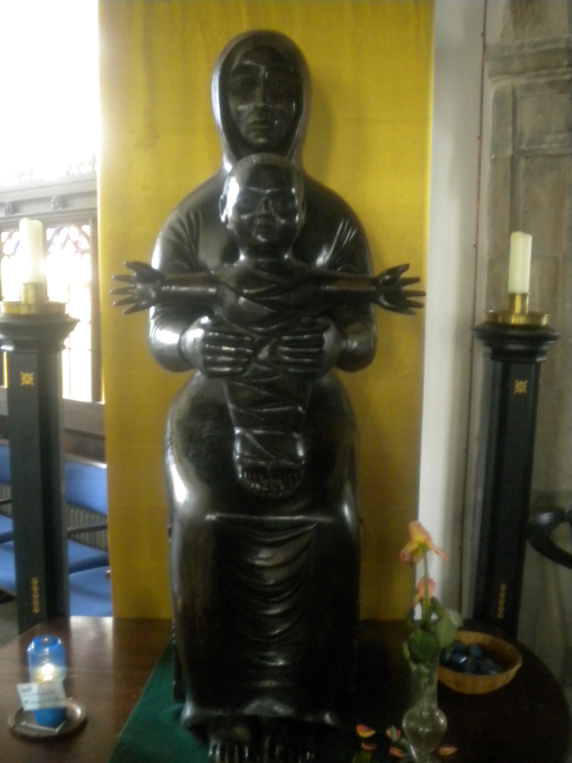
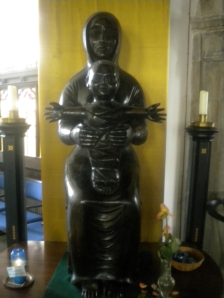
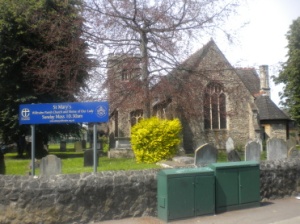
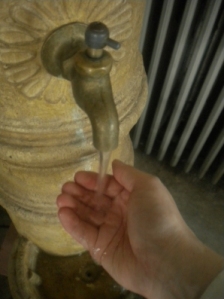
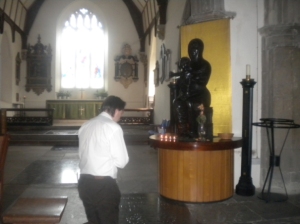
Pingback: Sunday Best: from old textbooks to new cartoonists
I wonder –Did the Catholic founder of Opus Dei say his Mass in the C of E Shrine Church of Our Lady of Willesden, –or the RC Church and shrine of Our Lady of Willelsden, a mile away ? There are two shrines of the same name, separated by the English reformation.
Hello, Aunt Raven. Yes indeed, there is a Roman Catholic church dedicated to Our Lady of Willesden in Harlesden. I think it’s now the Brazilian church. As far as I can tell from the accounts of the event, Josemaría Escrivá frequented the actual site of the shrine, the Anglican church, and was given permission to say Mass there. From an Anglican point of view, giving permission for a Roman Catholic Mass in an Anglican church is not a big deal.
Delighted to hear it!
Sorry to disappoint you, but your information is incorrect. The National Shrine of Our Lady of Willesden is the Catholic Church in the area. The current church was built as a Shrine Church in 1930, the 3rd Catholic Shrine since the Reformation. It was here that S. Josemaria Escriva came on several occasions in the 50’s, and we regularly receive pilgrims from Opus Dei who follow in the saint’s footsteps. Indeed, the there is now a sign board outside the Shrine which includes the first public representation of the saint in an English parish church. Opus Dei have also entrusted a relic of S. Josemaria to the parish in remembrance of his devotion and his visits to the Shrine.
The Shrine Church continues to act as the Catholic parish church for this part of NW10, and due to the large local population of Brazilians offers 6 weekend masses, 2 in Brazilian Portuguese and 4 in English for a large and vibrant multi-cultural community.
Now I am REALLY confused. Please could you give me the exact address of the church you visited as described above. I live a 20 minute cycle ride from Willesden and have always wanted to visit a holy well. I found your blog whilst looking online for the church which has the holy well. I would like to visit the water source, but don’t want to end up at the wrong church! Is the water drinkable, or is the the sort of holy water for sprinkling only? Can one fill up a bottle to take home?
Pingback: Urban Dowsing